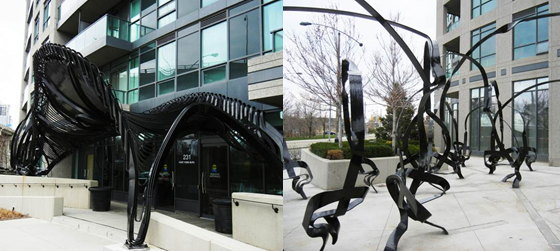Designer/architect Vito Acconci began his career as a poet and performance/installation artist. What interested him most about the literary arts was the blank page; the inertia of reading and writing. How do you transverse a page? What makes you go from left to right, from one page to the next. However, he soon began to think if he was so interested in movement, why was he limiting himself to this page? It was from this moment that he became an artist.

Journalist Alex Newman wrote that the sculpture arcs smoothly over the front entry, subsiding in black fencing that skirts the building while creating seating for passersby. Zoning for the building required a fence and New York-based artist Acconci determined it should not be predictable. He envisioned something that would allow people to imagine and create for themselves how they might use the space because “people shouldn’t be subservient to architecture.”
The Acconti installation is one in a series of public art projects (Chinese artist Zhang Huan and Toronto artist Katharine Harvey to name a few) that are just the tip of Toronto’s public art collection and they’re mostly thanks to a convergence of political will and private money. Developers are required to spend 1 per cent of hard building costs on public art, and thanks to the building boom, there is a large concentration downtown.
Even so, the scope of the art seems to be exponentially greater than the increased cost of building condos. Accumulating public art is a tourist draw — for example, Chicago’s vast collection of public art and architecture draws tourists by the droves. There’s the investment in civic pride, which in Toronto is starting to see a return. As the Toronto Star’s Christopher Hume wrote in a recent column, “Toronto has embraced cityhood. Leading the way are its architects,” whose role, Hume added, “is not just designing structures, but building a city.”